 From the Oregonian, 08.30.07:
From the Oregonian, 08.30.07:
MAX wants easy ride for bikersNote that one solution not suggested here is to add more cars to each train, or add more frequent trains, which would not only add capacity and reduce crowding tension, but improve service for every transit user, on bikes or not. In any event, this is a good problem to have. And Portland has done more than almost any other city in the U.S. to encourage alternatives to driving.
More cyclists are using light rail, and the crowds have caused clashes
MAX is becoming a victim of its own success. Ridership on the light-rail system is rising as gas prices remain high, getting more cars off the road. A growing number of those passengers are bicyclists who use the trains, reducing congestion at both ends of their commute.
But when bikers and nonbikers wind up on the same crowded train at rush hour, tempers sometimes flare. TriMet officials are looking for ways to reduce that friction, short of restricting the number of bikes on trains during rush hour.
The growth in MAX ridership and bicycle commuting reflects "two really positive trends," said Eric Hesse, a strategic planning analyst for TriMet. Planners are looking at a number of possible solutions. They want to know, among other things, whether installing more bike lockers at MAX stations would reduce the number of cycles on the train, Hesse said. The agency might encourage the use of folding bicycles to save space. Finding ways to install more bicycle hooks is also an option. (Read more.)
Image: BikePortland.org
Visit: Paul Dorn's Bike Commuting Tips
















